Exploring Appreciative Inquiry in Effective Shift Leadership
VerifiedAdded on 2023/06/06
|5
|1054
|481
Essay
AI Summary
This essay examines the application of appreciative inquiry in shift leadership, focusing on how leaders can leverage this approach to enhance team performance and achieve organizational goals. The analysis highlights the challenges faced by leaders, such as centralization of power, and emphasizes the importance of communication skills and strong leader-employee relationships. It discusses the significance of employee development methods like mentoring, training, and coaching. The reflection underscores the value of shift stories and mind maps in cultivating a positive work environment and promoting a culture of continuous improvement. Furthermore, the essay identifies transformational leadership as crucial for successful organizational shifts, emphasizing the need for leaders to support employee growth and resolve conflicts effectively. The conclusion reinforces the alignment of leadership styles with the appreciative inquiry model, particularly in coordinating employees, assigning duties, and motivating the team to achieve objectives.
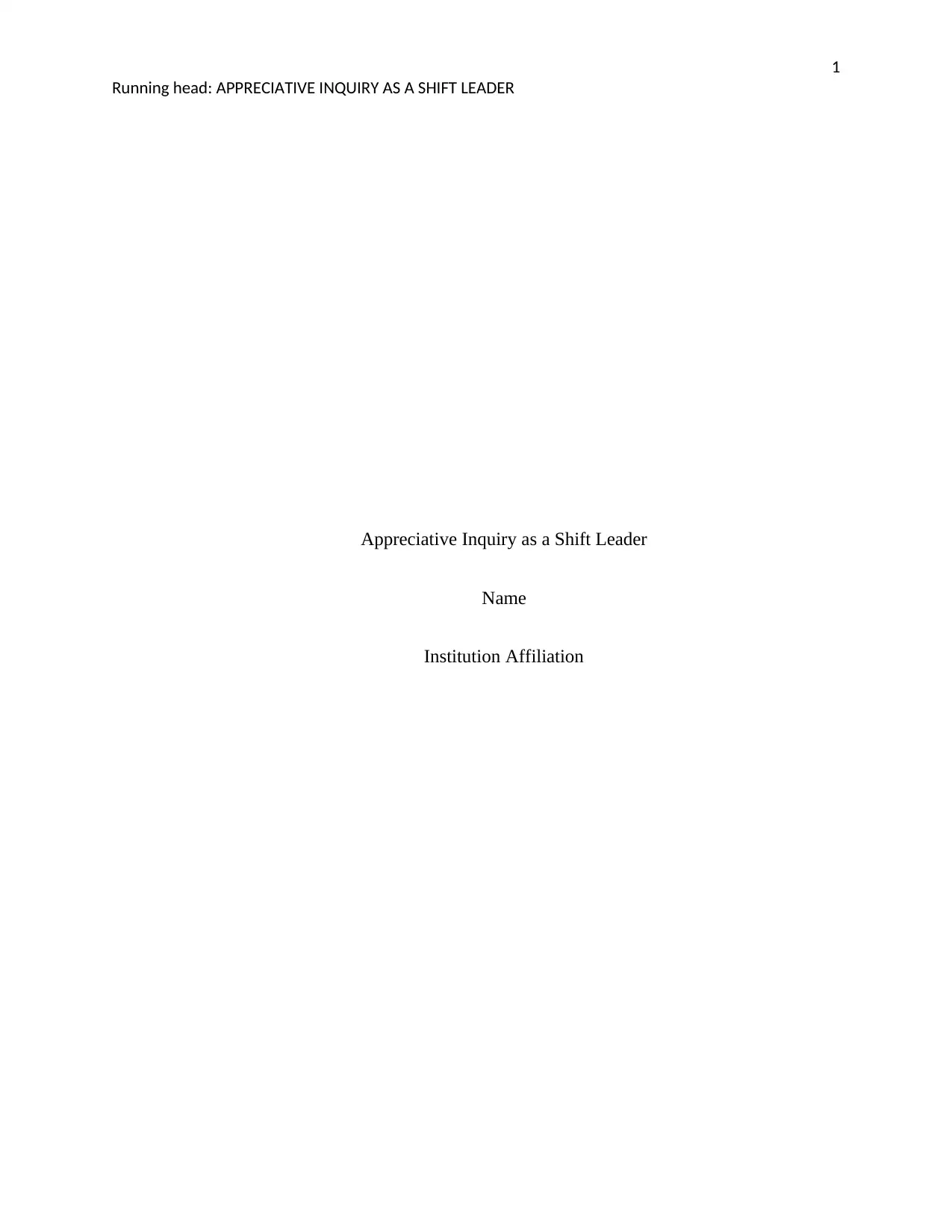
1
Running head: APPRECIATIVE INQUIRY AS A SHIFT LEADER
Appreciative Inquiry as a Shift Leader
Name
Institution Affiliation
Running head: APPRECIATIVE INQUIRY AS A SHIFT LEADER
Appreciative Inquiry as a Shift Leader
Name
Institution Affiliation
Paraphrase This Document
Need a fresh take? Get an instant paraphrase of this document with our AI Paraphraser
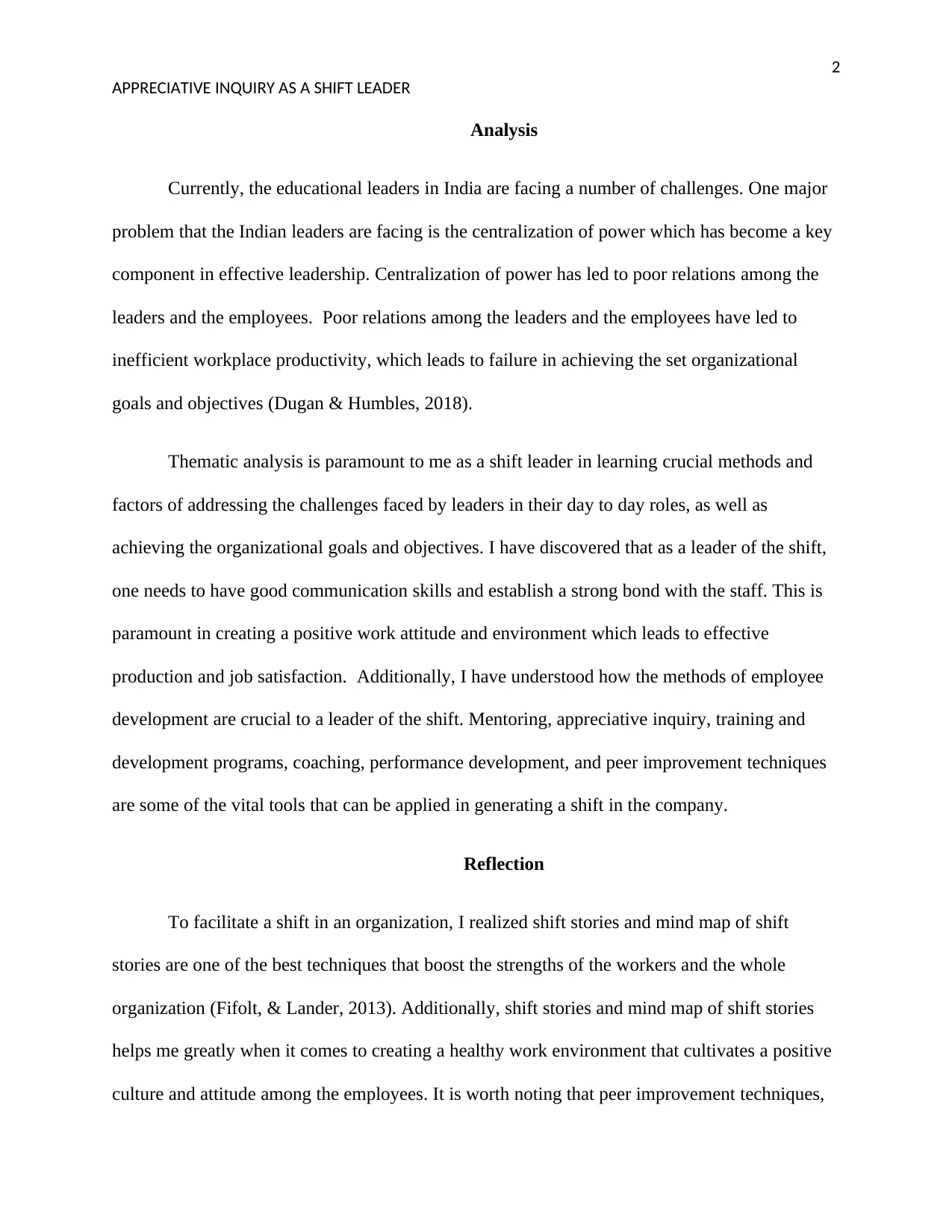
2
APPRECIATIVE INQUIRY AS A SHIFT LEADER
Analysis
Currently, the educational leaders in India are facing a number of challenges. One major
problem that the Indian leaders are facing is the centralization of power which has become a key
component in effective leadership. Centralization of power has led to poor relations among the
leaders and the employees. Poor relations among the leaders and the employees have led to
inefficient workplace productivity, which leads to failure in achieving the set organizational
goals and objectives (Dugan & Humbles, 2018).
Thematic analysis is paramount to me as a shift leader in learning crucial methods and
factors of addressing the challenges faced by leaders in their day to day roles, as well as
achieving the organizational goals and objectives. I have discovered that as a leader of the shift,
one needs to have good communication skills and establish a strong bond with the staff. This is
paramount in creating a positive work attitude and environment which leads to effective
production and job satisfaction. Additionally, I have understood how the methods of employee
development are crucial to a leader of the shift. Mentoring, appreciative inquiry, training and
development programs, coaching, performance development, and peer improvement techniques
are some of the vital tools that can be applied in generating a shift in the company.
Reflection
To facilitate a shift in an organization, I realized shift stories and mind map of shift
stories are one of the best techniques that boost the strengths of the workers and the whole
organization (Fifolt, & Lander, 2013). Additionally, shift stories and mind map of shift stories
helps me greatly when it comes to creating a healthy work environment that cultivates a positive
culture and attitude among the employees. It is worth noting that peer improvement techniques,
APPRECIATIVE INQUIRY AS A SHIFT LEADER
Analysis
Currently, the educational leaders in India are facing a number of challenges. One major
problem that the Indian leaders are facing is the centralization of power which has become a key
component in effective leadership. Centralization of power has led to poor relations among the
leaders and the employees. Poor relations among the leaders and the employees have led to
inefficient workplace productivity, which leads to failure in achieving the set organizational
goals and objectives (Dugan & Humbles, 2018).
Thematic analysis is paramount to me as a shift leader in learning crucial methods and
factors of addressing the challenges faced by leaders in their day to day roles, as well as
achieving the organizational goals and objectives. I have discovered that as a leader of the shift,
one needs to have good communication skills and establish a strong bond with the staff. This is
paramount in creating a positive work attitude and environment which leads to effective
production and job satisfaction. Additionally, I have understood how the methods of employee
development are crucial to a leader of the shift. Mentoring, appreciative inquiry, training and
development programs, coaching, performance development, and peer improvement techniques
are some of the vital tools that can be applied in generating a shift in the company.
Reflection
To facilitate a shift in an organization, I realized shift stories and mind map of shift
stories are one of the best techniques that boost the strengths of the workers and the whole
organization (Fifolt, & Lander, 2013). Additionally, shift stories and mind map of shift stories
helps me greatly when it comes to creating a healthy work environment that cultivates a positive
culture and attitude among the employees. It is worth noting that peer improvement techniques,
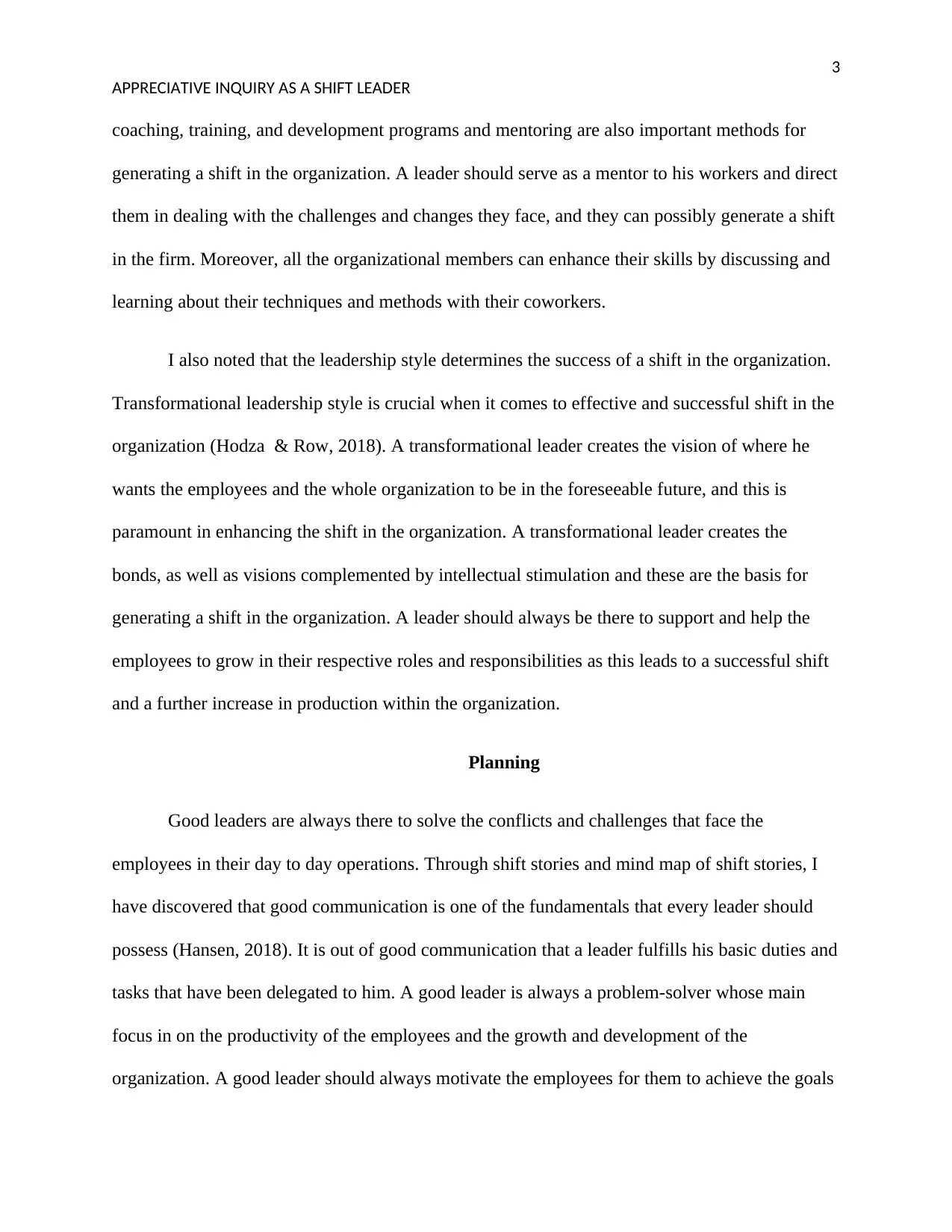
3
APPRECIATIVE INQUIRY AS A SHIFT LEADER
coaching, training, and development programs and mentoring are also important methods for
generating a shift in the organization. A leader should serve as a mentor to his workers and direct
them in dealing with the challenges and changes they face, and they can possibly generate a shift
in the firm. Moreover, all the organizational members can enhance their skills by discussing and
learning about their techniques and methods with their coworkers.
I also noted that the leadership style determines the success of a shift in the organization.
Transformational leadership style is crucial when it comes to effective and successful shift in the
organization (Hodza & Row, 2018). A transformational leader creates the vision of where he
wants the employees and the whole organization to be in the foreseeable future, and this is
paramount in enhancing the shift in the organization. A transformational leader creates the
bonds, as well as visions complemented by intellectual stimulation and these are the basis for
generating a shift in the organization. A leader should always be there to support and help the
employees to grow in their respective roles and responsibilities as this leads to a successful shift
and a further increase in production within the organization.
Planning
Good leaders are always there to solve the conflicts and challenges that face the
employees in their day to day operations. Through shift stories and mind map of shift stories, I
have discovered that good communication is one of the fundamentals that every leader should
possess (Hansen, 2018). It is out of good communication that a leader fulfills his basic duties and
tasks that have been delegated to him. A good leader is always a problem-solver whose main
focus in on the productivity of the employees and the growth and development of the
organization. A good leader should always motivate the employees for them to achieve the goals
APPRECIATIVE INQUIRY AS A SHIFT LEADER
coaching, training, and development programs and mentoring are also important methods for
generating a shift in the organization. A leader should serve as a mentor to his workers and direct
them in dealing with the challenges and changes they face, and they can possibly generate a shift
in the firm. Moreover, all the organizational members can enhance their skills by discussing and
learning about their techniques and methods with their coworkers.
I also noted that the leadership style determines the success of a shift in the organization.
Transformational leadership style is crucial when it comes to effective and successful shift in the
organization (Hodza & Row, 2018). A transformational leader creates the vision of where he
wants the employees and the whole organization to be in the foreseeable future, and this is
paramount in enhancing the shift in the organization. A transformational leader creates the
bonds, as well as visions complemented by intellectual stimulation and these are the basis for
generating a shift in the organization. A leader should always be there to support and help the
employees to grow in their respective roles and responsibilities as this leads to a successful shift
and a further increase in production within the organization.
Planning
Good leaders are always there to solve the conflicts and challenges that face the
employees in their day to day operations. Through shift stories and mind map of shift stories, I
have discovered that good communication is one of the fundamentals that every leader should
possess (Hansen, 2018). It is out of good communication that a leader fulfills his basic duties and
tasks that have been delegated to him. A good leader is always a problem-solver whose main
focus in on the productivity of the employees and the growth and development of the
organization. A good leader should always motivate the employees for them to achieve the goals
⊘ This is a preview!⊘
Do you want full access?
Subscribe today to unlock all pages.

Trusted by 1+ million students worldwide
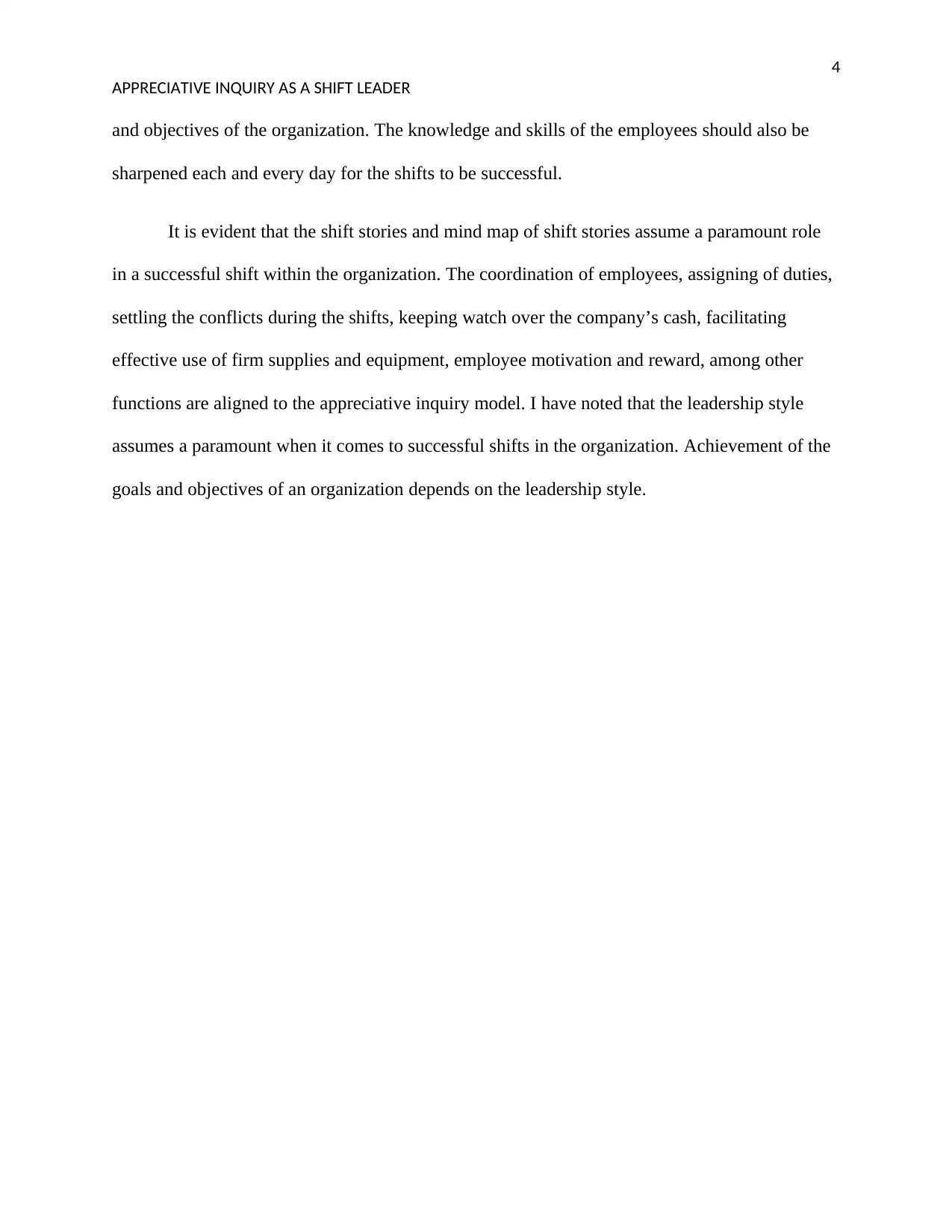
4
APPRECIATIVE INQUIRY AS A SHIFT LEADER
and objectives of the organization. The knowledge and skills of the employees should also be
sharpened each and every day for the shifts to be successful.
It is evident that the shift stories and mind map of shift stories assume a paramount role
in a successful shift within the organization. The coordination of employees, assigning of duties,
settling the conflicts during the shifts, keeping watch over the company’s cash, facilitating
effective use of firm supplies and equipment, employee motivation and reward, among other
functions are aligned to the appreciative inquiry model. I have noted that the leadership style
assumes a paramount when it comes to successful shifts in the organization. Achievement of the
goals and objectives of an organization depends on the leadership style.
APPRECIATIVE INQUIRY AS A SHIFT LEADER
and objectives of the organization. The knowledge and skills of the employees should also be
sharpened each and every day for the shifts to be successful.
It is evident that the shift stories and mind map of shift stories assume a paramount role
in a successful shift within the organization. The coordination of employees, assigning of duties,
settling the conflicts during the shifts, keeping watch over the company’s cash, facilitating
effective use of firm supplies and equipment, employee motivation and reward, among other
functions are aligned to the appreciative inquiry model. I have noted that the leadership style
assumes a paramount when it comes to successful shifts in the organization. Achievement of the
goals and objectives of an organization depends on the leadership style.
Paraphrase This Document
Need a fresh take? Get an instant paraphrase of this document with our AI Paraphraser
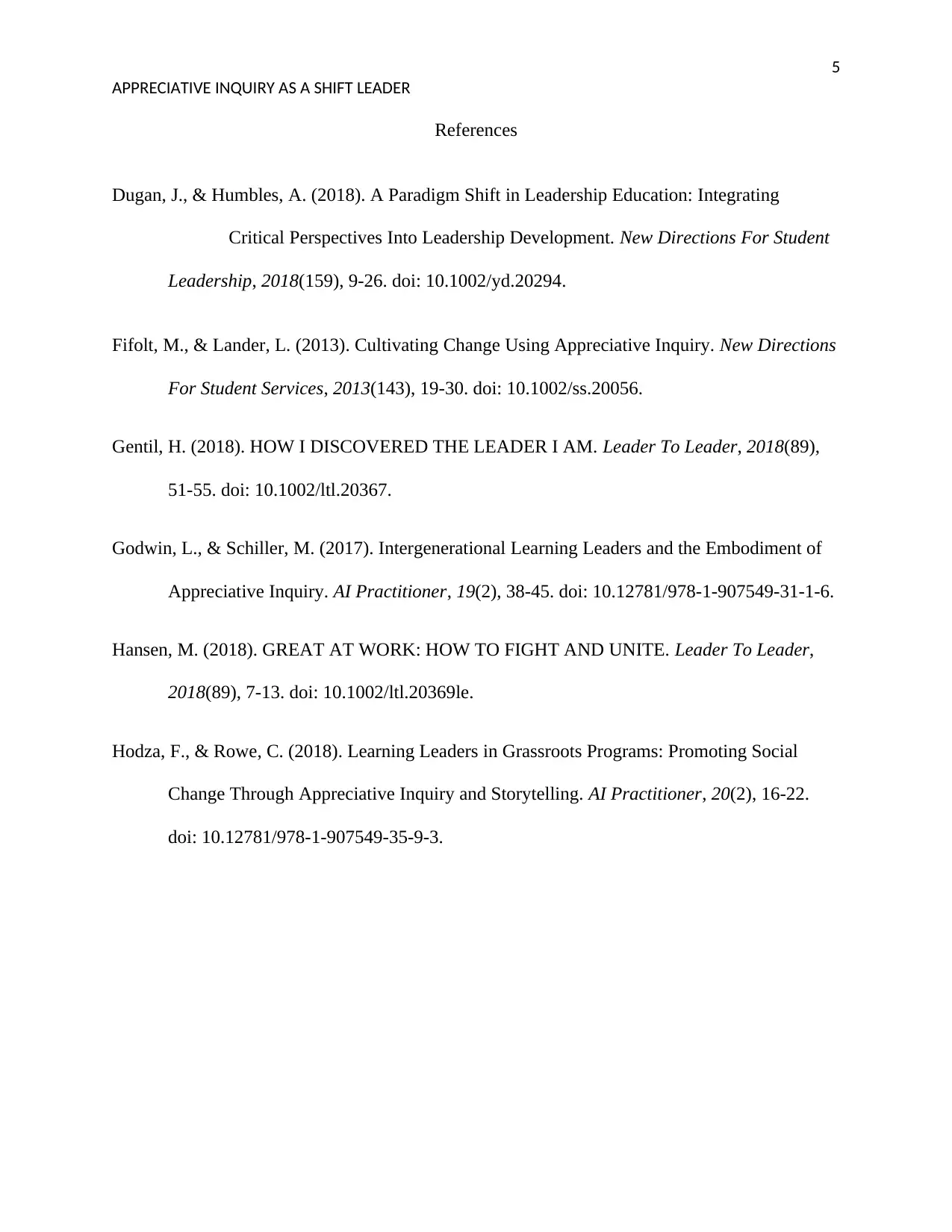
5
APPRECIATIVE INQUIRY AS A SHIFT LEADER
References
Dugan, J., & Humbles, A. (2018). A Paradigm Shift in Leadership Education: Integrating
Critical Perspectives Into Leadership Development. New Directions For Student
Leadership, 2018(159), 9-26. doi: 10.1002/yd.20294.
Fifolt, M., & Lander, L. (2013). Cultivating Change Using Appreciative Inquiry. New Directions
For Student Services, 2013(143), 19-30. doi: 10.1002/ss.20056.
Gentil, H. (2018). HOW I DISCOVERED THE LEADER I AM. Leader To Leader, 2018(89),
51-55. doi: 10.1002/ltl.20367.
Godwin, L., & Schiller, M. (2017). Intergenerational Learning Leaders and the Embodiment of
Appreciative Inquiry. AI Practitioner, 19(2), 38-45. doi: 10.12781/978-1-907549-31-1-6.
Hansen, M. (2018). GREAT AT WORK: HOW TO FIGHT AND UNITE. Leader To Leader,
2018(89), 7-13. doi: 10.1002/ltl.20369le.
Hodza, F., & Rowe, C. (2018). Learning Leaders in Grassroots Programs: Promoting Social
Change Through Appreciative Inquiry and Storytelling. AI Practitioner, 20(2), 16-22.
doi: 10.12781/978-1-907549-35-9-3.
APPRECIATIVE INQUIRY AS A SHIFT LEADER
References
Dugan, J., & Humbles, A. (2018). A Paradigm Shift in Leadership Education: Integrating
Critical Perspectives Into Leadership Development. New Directions For Student
Leadership, 2018(159), 9-26. doi: 10.1002/yd.20294.
Fifolt, M., & Lander, L. (2013). Cultivating Change Using Appreciative Inquiry. New Directions
For Student Services, 2013(143), 19-30. doi: 10.1002/ss.20056.
Gentil, H. (2018). HOW I DISCOVERED THE LEADER I AM. Leader To Leader, 2018(89),
51-55. doi: 10.1002/ltl.20367.
Godwin, L., & Schiller, M. (2017). Intergenerational Learning Leaders and the Embodiment of
Appreciative Inquiry. AI Practitioner, 19(2), 38-45. doi: 10.12781/978-1-907549-31-1-6.
Hansen, M. (2018). GREAT AT WORK: HOW TO FIGHT AND UNITE. Leader To Leader,
2018(89), 7-13. doi: 10.1002/ltl.20369le.
Hodza, F., & Rowe, C. (2018). Learning Leaders in Grassroots Programs: Promoting Social
Change Through Appreciative Inquiry and Storytelling. AI Practitioner, 20(2), 16-22.
doi: 10.12781/978-1-907549-35-9-3.
1 out of 5
Related Documents
Your All-in-One AI-Powered Toolkit for Academic Success.
+13062052269
info@desklib.com
Available 24*7 on WhatsApp / Email
![[object Object]](/_next/static/media/star-bottom.7253800d.svg)
Unlock your academic potential
Copyright © 2020–2025 A2Z Services. All Rights Reserved. Developed and managed by ZUCOL.





